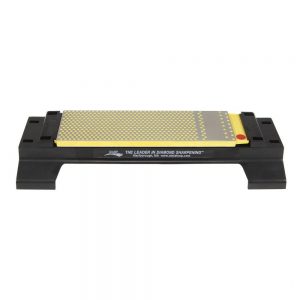Getting Gritty with DMT Diamond Sharpeners
Before December 2017, I’d never sharpened a knife. As a kid, I used to mimic the motion, but I didn’t know the finesse and subtlety that went into perfecting a blade’s edge. So when DMT’s DuoSharp® Bench Stone with Base and the Diamond Steel™ arrived in the newsroom, I jumped at the chance to get myself a crash course and see what sharpeners are all about.
Out of the box, I could tell there was a steeper learning curve for the bench stone than there was for the steel. Not that the bench stone was complicated — it came with 12 rubber feet to place on the bottom for stability. The edge had two grits already locked into the base by two clips, and removing the clips to change grit was as easy as giving them a pinch from the bottom. The steel was even less complicated: remove from box, then rinse. In minutes, I was ready to sharpen, and test out the results with carrots, onions and paper (after a few YouTube instructional videos, that is).
The Tomodachi All-Purpose 6-inch knife from my childhood wasn’t looking so hot when I first got to it. Tiny dents, dulling and other imperfections made slicing through even the softest foods a bit rough; the blade would snag on food and then aim for my fingers.
After about 10 minutes of sharpening on the fine grit, I ran the onion test to test basic sharpness; onion skin is oily and slick, so I was impressed to find that my knife could now catch on the skin with relative ease. The movement wasn’t quite as smooth as I would have liked, though. Each slice still caught a little bit, and I could tell that the blade was uneven. After about five minutes more of the fine grit on each side, and another five on each side with extra fine grit, the Tomodachi was slicing paper-thin tomatoes and cutting carrots like butter. When I did the paper test, the knife slid just as easily through the page as carrots, like I’d expect from a crafter’s razorblade. The DMT Bench Stone (W8) had my knife slicing like it was 2008 instead of 2018.
According to the instructions, I could have sharpened dry, but I went wet because the fluid floats away the swarf (waste material), which keeps the stone from clogging. Though my results were exactly what I was looking for, my only regret was that I couldn’t repair the worst of my knives, which was rife with dents and extensive damage from drawer storage and misuse. For that, I’d need more than the fine and extra fine grits that came in the package. DMT’s Diamond Sharpener grits come in extra extra coarse, extra coarse, coarse, fine, extra fine and extra-extra fine, all color-coded on the package and on the edge itself to help users stay organized and efficient. For home cooks and chefs who are serious about keeping their knives in perfect working condition, I recommend getting a wider range of grits.
The Diamond Steel was a cinch to use, even for a beginner like me. All I needed was a cutting board, the steel and a slightly damaged Hoffritz knife. Again, getting the stroke right from heel to tip took a bit of practice and some direction from strange YouTubers, but I had it down in less than 10 minutes. Since my knife wasn’t too badly damaged, it was slicing paper-thin tomatoes by the time I finished practicing!
Nice as the bench stone was for sharpening, I rarely have damaged knives to fix, so it takes a little too much space in my studio-style apartment. However, DMT’s sharpeners proved to be just what I needed to get a couple knives back into working condition. These are a must-have for anyone who uses a knife every day, though most of us home cooks and small-living folks will be fine with the Diamond Steel on its own, which fits in my knife block or kitchen counter carousel.


You must be logged in to post a comment.